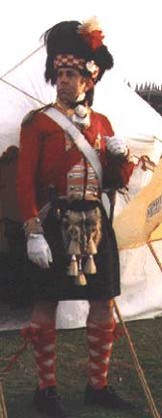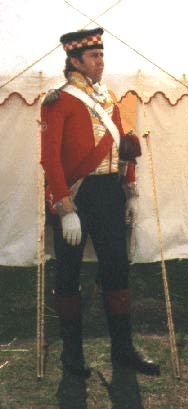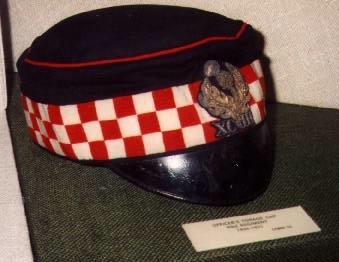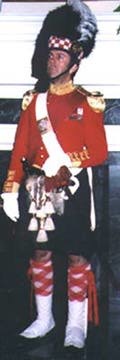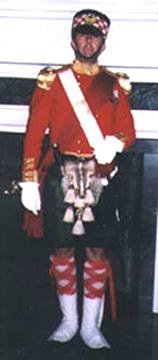WELCOME TO THE OFFICERS' MESS
"Whisky for the gentlemen that like it and for the gentlemen who don't like it, whisky."
("Tunes of Glory", by James Kennaway)
"Whisky for the gentlemen that like it and for the gentlemen who don't like it, whisky."
("Tunes of Glory", by James Kennaway)
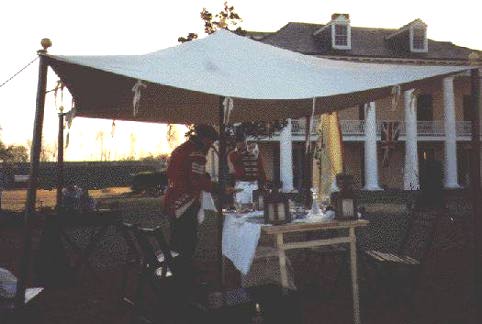
DRESS REGULATIONS - NAPOLEONIC ERA
copyright 1997
OFFICERS - BATTALION COMPANY
|
Note that there was no skean dubh worn. These were not adopted for wear until officers of the 42nd began placing them in the top of the kilt hose in the 1840's as decoration, made regulation in the 93rd in 1853.
Officers generally paid for most or all of their own kit and equipment.
|
DRESS REGULATIONS - FLANK COMPANIES (Grenadier and Light Companies)
Differences from above.JACKETS: Epaulettes were formed as part of flank company wings on shoulders. Grenadier officers' would include the grenade emblem, Light Co. officers the bugle horn emplem.
BONNET: Grenadier: White tourie and all white hackle. Light Company: Green tourie and hackle.
SWORD BALDRIC: Light Company - fitted with slings.
93rd Officer, Battalion Company, in Marching Order uniform as worn during the Battle of New Orleans, circa Dec.1814 - Jan.1815

OFFICER DRESS REGULATIONS, BATTALION COMPANY - CRIMEAN ERA, 1854-1855 ©1998
JACKET: Full dress & marching order. Scarlet superfine "doeskin" wool. "1836" pattern. Double breasted. Short tails. Lemon Yellow doeskin wool collar, cuffs and shoulder straps. Cuffs, round, "slash" of red wool, scalloped in 3 points Vertically-set false pocket flaps on tails. White doeskin wool turnbacks on tails, tails lined in white wool.
Regimental Lace & buttons: Gold. Loops to be straight pointed. 4 each cuff slash, 4 each back pocket flap spaced evenly both ends squared. Triangle at back center waist. Outside edges of turnbacks. Epaulettes: Gold, 2 for all officers. Rank placed on epaulette straps. Turnback badges: Embroidered Scottish regimental.
KILT: Full dress & marching order. Government (Black Watch) tartan. Box pleats showing green of sett. No kilt pin.
TREWS: Undress uniform. Navy blue wool or tartan.
SPORRAN: Full dress & marching order. Badger with head mask, 6 white tassels in gilt bells edged in red leather, engraved with thistles, narrow brass cantle edged in red leather, black leather belt with silver buckle.
Feather BONNET: Full dress & marching order. Dark navy blue wool. Stiffened to stand up. Wire cage affixed to hold black ostrich feathers encircling cage. 6 feather "tails" on right side. Dicing of woven wool, alternating red and white only. Black ribbon cockade. Regimental silver & gilt badge. White vulture feather hackle. Chin strap: black leather, silver buckle. Oilcloth cover painted black.
PEAKED CAP: Undress. Round, navy blue wool, pillbox style with black leather peak (visor). Red piping. Red and white regimental dicing. Embroidered 93rd badge. Black leather chin strap.
Original 93rd officer's peaked cap, United Scottish Services Museum, Edinburgh Castle.
SHOES: Undress and campaign: Black leather Ankle boot. Full dress: Black leather buckled shoes, silver buckles.
BOOTS: Black leather. Worn with trousers in undress or when mounted.
SPATTERDASHES : (Gaiters or Spats) White canvas. Worn in field with kilt, not worn in full dress.
KILT HOSE: Wool, red and white diced. Cuff top turned down over garter.
GARTERS: Red ribbon. Ends cut in swallowtails. Tied in rosette, ends worn long to the ankle.
SWORD BALDRIC: White buff leather. Worn over right shoulder under epaulette. Slings attach to rings on scabbard. BELT PLATE: Gilt and Silver 93rd Regimental.
GLOVES : White leather. Worn on all duty.
SASH: Red (crimson) silk with tassel ends. Worn over left shoulder under epaulette and under baldric in front, over baldric in back. Tied in rosette on right hip.
SWORD: Basket hilt Scottish broadsword. Red fabric basket lining. Red fringe at pommel.
SCABBARD: Black leather with brass mountings and 2 sling rings.
PLAID: Government tartan. Worn over left shoulder in full dress. Silver regimental brooch. Field officers wore silk tartan scarf plaid over the sash on the left shoulder, and also worn on campaign.
DIRK: Full dress. Black wood hilt, silver fittings. Black leather scabbard, silver fittings. Black leather belt with regimental buckle. Dirk worn on right front hip. Often worn in the field.
SGIANDUBH: Full dress. Small knife. Black wood hilt, black leather scabbard, silver fittings. Worn in right hose top.
UNDRESS SHELL JACKET: Scarlet doeskin wool with yellow doeskin facings. Single breasted. Twisted gold shoulder cords with double ends. Plain high yellow collar. Pointed yellow cuffs. 12 small Regimental buttons down front. Black leather DIRK BELT worn underneath jacket.
FROCK COAT: Walking or riding - never on duty. Navy blue wool. Single breasted. 8 gilt Regimental buttons. Plain, high collar. Worn with black leather SWORD BELT and SASH.
HAIR: Facial hair was allowed at this time.
93rd Battalion Company Officer, 1854. Full Dress as well as Marching Order uniform. This is the officers' uniform of "The Thin Red Line".
Though not "regulation" by wearing of the peaked forage cap, there is plenty of photographic documentation showing that Highland officers in the Crimea at times wore the uniform in just such a manner, as well as in other forms due to the "exigency of service".

